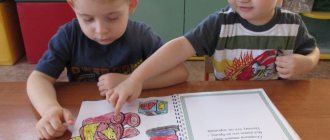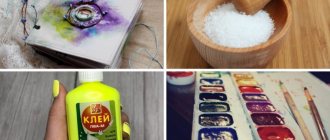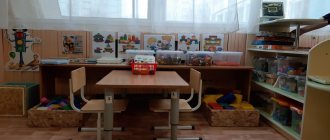Card index of games in the center “Sand - Water” card index on the topic
CARD INDEX OF GAMES FOR EARLY CHILDREN
.
helps the teacher in solving one of the most important tasks in the development of a 2-3 year old child. We are talking about independent activity - experimenting with various suitable objects and natural materials. By organizing games with sand and water, the teacher not only introduces children to the properties of various objects and materials, but also reinforces basic ideas about the shape, size, color of objects, and develops the child’s fine motor skills. Kids love these games very much. You can pour sand from palm to palm, from a scoop into a mold, you can hide all sorts of small toys in the sand, build buildings, and then destroy them and build them again. It is noted that games with sand and water are more stable and focused than other games. Sand buildings can be considered the beginning of construction; it forces the child to concentrate. Playing with water evokes positive emotions and promotes inner relaxation. Working with children in Russia requires certain conditions; The center should be located so that it is easy to clean and that children can approach it from all sides. It is necessary to stock up on waterproof aprons, sand molds, and various washable toys.
Equipment option.
To play with sand and water, you need scoops, a variety of molds, small toys for burying (balls, cubes, rings and other geometric shapes of different colors, sizes), sticks, rakes.
For games with water - a set of rubber and plastic toys, a net, a scoop, multi-colored plastic balls, a set of toys made of various materials (floats or sinks for games). A set of pebbles, shells, etc.
Game “I bake, bake, bake”
Goal: familiarization with the properties of sand, development of coordination of movements, hand motor skills.
Contents: The child “bakes” buns, pies, and cakes from sand. To do this, the baby can use a variety of molds, pouring sand into them, compacting them with his hand or a scoop. You can also “bake” pies with your hands, transferring wet sand from one palm to another. Then the child “treats” the pies to the dolls.
Game "Warm" or "Cold"
Purpose: to consolidate the concept of “warm” or “cold”.
Contents: Two types of toys are needed, two to three of each, preferably rubber or plastic (for example: ducklings, fish, boats, dolphins and small balls - red, blue, yellow, white).
The teacher fills one container with warm water and the other with cold water. He tells the children: “Ducklings like to swim in cold water, and fish in warm water. Let's bathe them." The kid puts the ducklings in a container with cold water, and the fish in warm water. Thus, we teach the child not only the properties of objects, but also teach him to determine the difference between cold and warm.
The game “What floats?”
Purpose: To introduce children to the properties of materials.
Contents: For the game - experimentation, you need a set of objects from different materials. A plastic boat, a rubber duck, a metal spoon, a pebble, a paper boat, a nut shell, a piece of fabric, a foam figurine, a wooden stick, etc.
The teacher invites the child to gradually lower all the objects into the water: “What a beautiful boat!” He is ready to go on a journey, to sail. Let him go into the water and let him swim. We have so many items, let’s let them go too, they want to swim.” During the game, the teacher asks the child to name the objects that are lowered into the water. Comment on the actions of objects (sinking, floating, getting wet).
Game "Captains".
Goal: activation of the lip muscles, development of the ability to alternate long, smooth, strong exhalations.
Contents: The teacher fills a container with water and launches a paper boat into it. The child sits on a chair nearby. An adult invites the child to take a boat ride from one shore to the other. Shows that the banks are marked with stripes of different colors. He explains that in order for the boat to move, you need to blow on it. You can simply blow by stretching your lips with a tube without puffing out your cheeks. Shows how to do it. Draws the child’s attention to the sound that is produced: “F.” The kid repeats. “But then the wind came, it was not blowing smoothly. That’s it!” - the adult blows on the boat abruptly, not evenly: “P-P-P.” Draws the baby's attention to what sound is heard now - “P.” He suggests trying to blow and drive the boat to the other shore. The game is repeated several times. The teacher makes sure that the child does not puff out his cheeks or blow too hard. During games, the teacher must praise the child for correctly completing the task, support and help, and in no case reproach the child for spilling water, scattering sand, or getting his clothes wet. Playing with sand and water should bring joy to children.
Game "Catch a piece of ice".
Goal: development of coordination of movements, familiarization with the properties of water.
Contents: The teacher puts 5 - 10 small pieces of ice into a container of water and says to the child: “Look, look what’s happening. The ice floes were big, but they are becoming small. Let's save them!"
The child, using a net or scoop, takes out larger pieces of ice from the water and puts them in a separate bowl. After all the pieces of ice have been removed, the teacher asks: “Where did the rest of the pieces of ice go?” What happened to them? “They melted and turned into water.”
Game "Get the shell."
Goal: development of attention to coordination of movements.
Contents: An adult places several pebbles and shells at the bottom of a container with water. Then he invites the child to find the “treasure”. To do this, he chooses a very beautiful stone or shell and looks at it together with the baby. Then the pebble or shell sinks to the bottom (depth no more than 15-20 cm), the child must try to get it by finding the desired item among other stones and shells. The watery layer usually makes it difficult to get out, so an adult can help the baby a little. This activity can be recommended to parents for playing with their child on the seashore or river.
Game "Find the ball".
Goals: familiarization with the quality of objects - size, shape.
Contents: The teacher buries a small ball in the sand and asks the child to find it. First, you can bury the ball in front of the baby’s eyes, then so that he cannot see the adult’s actions. Gradually complicating the task, the teacher buries two objects, for example a ball and a cube, then asks to find one of them. You can bury objects of the same shape, but of different sizes.
Game "Bake cookies".
Goal: familiarization with the properties of sand, development of motor skills, coordination of movements.
Contents: One container contains dry sand, the other contains wet sand. The teacher shows the child beautiful molds of different styles and offers to bake cookies. The child tries to perform actions with dry sand and wet sand. Gradually, as a result of the game, the child understands that nothing can be built from dry sand, but it can be built from wet sand. If necessary, the teacher provides assistance to the child or guides his actions verbally.
Updating the developmental subject-spatial environment of the second junior group of kindergarten.
Tatyana Mukhina
Updating the developmental subject-spatial environment of the second junior group of kindergarten.
Everyone knows that, in accordance with the Federal State Educational Standard for Preschool Education, a developing subject-spatial environment is part of the educational environment , represented by specially organized space, materials, equipment and inventory for the development of preschool children in accordance with the characteristics of each age stage, protecting and strengthening them health, taking into account the characteristics and correction of deficiencies in their development . The organization of a developing subject-spatial environment is especially relevant , since it makes it possible to develop the individuality of each child, taking into account his inclinations, interests, and level of activity.
A developing subject-spatial environment must be content-rich, transformable, multifunctional, accessible, variable and safe. We all know that children’s activity centers should be created groups . Today I want to bring to your attention one of the centers -
.
Watching the activities of the children on a walk, I noticed that playing with sand was monotonous, so the idea came to update it
in
the group .
Dear teachers! I invite you to our “ Sand Courtyard ”
There is a shelf nearby, and it tells the children that everyone needs instruments to play properly.
Various toys, Sponges and shells, Pebbles, funnels, Jars and nets, Tubes and sprinklers, Everything you need to play.
You can use objects , pour, dig, pour, and, of course, be sure to follow the Rules for everyone, in our sandy , only play in pairs.
Preview:
Article on the topic: Using the center of sand and water in the cognitive activity of children of the second younger group"
The requirements of the Federal State Educational Standard for Educational Education pay great attention to cognitive and research activities. Having analyzed the psychological, pedagogical and methodological literature, we can highlight the experimental method in the development of the cognitive interests of children of primary preschool age as a topical topic at the present stage. The relevance of the topic is due to the fact that the child acts as a kind of researcher, influencing the objects around him in various ways in order to more fully understand and master them. Early age is the most favorable time for accumulating ideas about the world around us. The leading cognitive process at an early age is perception. Its importance is difficult to overestimate. If a child does not receive components that contribute to the development of perception, then he may develop serious gaps in his ideas about a number of properties of objects and phenomena in the world around him.
A child’s perception of the world in the second and third years of life comes through feelings and sensations. These children are trusting and spontaneous, easily involved in joint practical activities with adults, and enjoy manipulating various objects. As practice shows, if a child is not taught exploratory actions and the ability to observe at an early age, then in the future he does not always show a stable interest in activities and experiences a feeling of fear when becoming familiar with new objects.
This problem can be solved if, from an early age, the child is actively introduced to the natural world, which opens up great opportunities for cognitive activity.
This requires a systematic approach that allows the child to be involved in searching, creative activities every day, contributing to the formation of his research actions.
The main tasks of forming perception are integrated with the tasks of developing speech, movements, and gaming skills. A series of observations, experiences and experiments contributes to the formation of cognitive interest in children, the development of observation and emotionality in communication with the outside world.
The formation of research actions occurs in substantive activities. For its successful organization it is necessary to create a non-standard, innovative subject-development environment.
The implementation of this approach to the development of perception of young children allows us to stimulate the need to understand the world around us. They master sensory standards well (color, shape, size, group, find and name objects in the immediate environment, correlate objects according to selected characteristics. Together with adults, they perform some research activities, use them in independent activities. They show interest, curiosity, and cheerfulness.
In the second younger group, the sensory corner is especially popular. Children enjoy studying in it, which confirms all of the above. I would like to pay special attention to the center of sand and water. I believe that familiarizing children with the properties of sand and water is necessary for a three-year-old child to fully perceive the world around him. Knowledge begins with the perception of objects and phenomena of the surrounding world. When a child gets acquainted with the phenomena of inanimate nature, during which he learns something new, this contributes to the development of not only his thinking, but also other aspects of his personality. Thus, experimentation is leading during the first 3-4 years of life and practically the only way to understand the world.
The Sand and Water Center helps solve one of the most important tasks in a child’s development. We are talking about independent activity - experimenting with various objects suitable for this activity. By organizing games with sand and water, we not only introduce children to the properties of various objects and materials, but also reinforce basic ideas about the shape, size, color of objects, and develop the child’s fine motor skills.
Kids love these games very much. A prerequisite for the center to work is the presence of fairy-tale characters during the game (Curious Bunny, Teddy Bear, Squirrel, etc.) It is imperative to start playing with sand and water by saying hello to the sand. To do this, first place one palm, then the other, then place both palms and lightly press on the sand. Grains of sand stick to our palms, we rub our palms against each other. What do you feel? Then you can play with sand: pour it from palm to palm, from scoop to mold, you can hide it in the sand, and then look for various objects and build buildings. Sand buildings can be considered the beginning of construction. Playing with water evokes positive emotions in children, relieves tension, and promotes inner relaxation.
Organization in a group for young children.
1. Creation of conditions in the group that meet the hygiene and safety requirements when working with sand and water.
It is necessary to choose the right location; it can be a table placed in such a way that children have the opportunity to approach it from any side. it is necessary to design it colorfully and attractively for children, thereby stimulating the desire to spend free time in it and learn while playing. The Center should also be located so that it is easy to clean.
2. Equipment
For water and sand, it is necessary to select appropriate containers that are convenient and safe for children to use. In the same center there can be various stones in a separate box, and in the next one - small scoops, molds, small balls and easy-to-clean toys. It is not recommended to pile up. It is better to change objects for experimentation once a month (you can replace stones with wooden or iron objects, or paper, etc.). To play with water, you must have rubber or plastic toys, a scoop, a net, etc.
Children will have the opportunity to carry out experiments and experiments: pour water, throw stones and balls into the water, fill molds with sand, build simple buildings from sand. Children, under the guidance of a teacher, see and understand which objects sink and which do not sink in water and why, which sand can be sculpted from and which cannot. can be moved outside during the warm season.
It is also necessary to think about protective equipment (waterproof aprons, oilcloths, oversleeves). The teacher needs to talk with the children about the rules of conduct in this center and teach the children to cooperate with each other. There should not be many children in the center at the same time.
Source
Article “Features of organizing educational games with sand and water with young children”
"I bake, bake, bake"
The child “bakes” various products from sand (buns, pies, cakes). To do this, the baby can use a variety of molds, pouring sand into them, compacting them with his hand or a scoop. You can also “bake” pies with your hands, transferring wet sand from one palm to another. Then the child “treats” mom, dad, and dolls with pies.
"Fences"
The kid makes little fences in a circle with his hands. Behind such a fence you can hide a bunny from the evil gray wolf.
"Magic fingerprints in the sand"
The teacher and the child leave fingerprints on the wet sand of their hands and then complete them or add pebbles to create funny faces, fish, octopuses, birds, etc.
Games for children from 3 years old
"Warm" or "Cold"
Purpose: to consolidate the concept of “warm” or “cold”.
Content.
Two types of toys are needed, two to three of each, preferably rubber or plastic (for example: ducklings, fish, boats, dolphins and small balls - red, blue, yellow, white).
The teacher fills one container with warm water and the other with cold water. He tells the children: “Ducklings like to swim in cold water, and fish in warm water. Let's bathe them." The kid puts the ducklings in a container with cold water, and the fish in warm water. Thus, we teach the child not only the properties of objects, but also teach him to determine the difference between cold and warm.
“How does it float?”
Purpose: Introducing children to the properties of the material
Content.
To play and experiment, you need a set of objects made from different materials. A plastic boat, a rubber duck, a metal spoon, a pebble, a paper boat, a nut shell, a piece of fabric, a foam figurine, a wooden stick, etc.
The teacher invites the child to gradually lower all the objects into the water: “What a beautiful boat!” He is ready to go on a journey, to sail. Let him go into the water and let him swim. We have so many items, let’s let them go too, they want to swim.” During the game, the teacher asks the child to name the objects that are lowered into the water. Comment on the actions of objects (sinking, floating, getting wet).
"Captains"
Goal: activation of the lip muscles, development of the ability to alternate long, smooth, strong exhalations.
Content.
The teacher fills a container with water and launches a paper boat into it. The child sits on a chair nearby. An adult invites the child to take a boat ride from one shore to the other. Shows that the banks are marked with stripes of different colors. He explains that in order for the boat to move, you need to blow on it. You can simply blow by stretching your lips with a tube without puffing out your cheeks. Shows how to do it. Draws the child’s attention to the sound that is produced: “F.” The kid repeats. “But then the wind came, it was not blowing smoothly. That’s it!” - the adult blows on the boat abruptly, not evenly: “P-P-P.” Draws the baby's attention to what sound is heard now - “P.” He suggests trying to blow and drive the boat to the other shore. The game is repeated several times. The teacher makes sure that the child does not puff out his cheeks or blow too hard. During games, the teacher must praise the child for correctly completing the task, support and help, and in no case reproach the child for spilling water, scattering sand, or getting his clothes wet. Playing with sand and water should bring joy to children.






